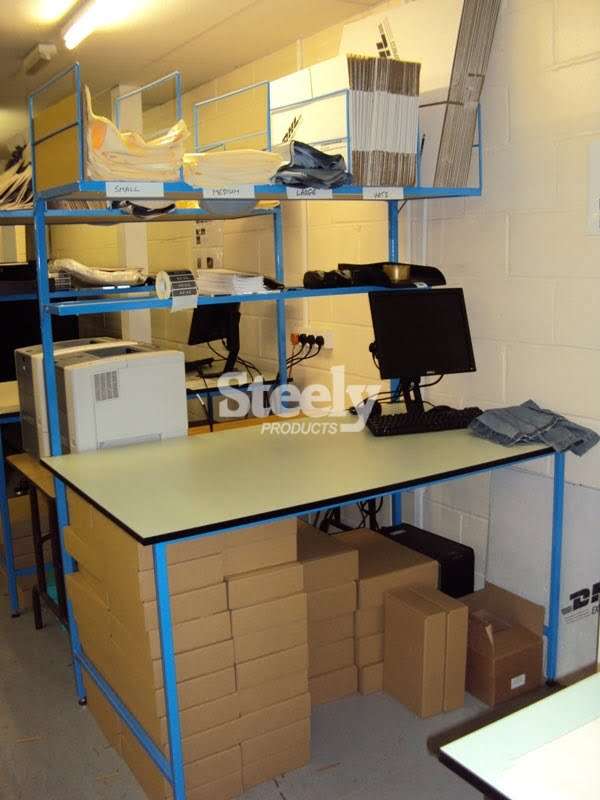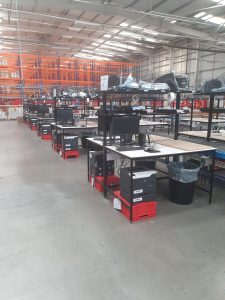Your basket is currently empty!


Warehouse operators are always looking to improve productivity to better serve their customers. Fast, efficient order processing leads to increased profits.
A key area of a warehouse operation that processes customer orders is the packing station. Here’s a guide to improving packing efficiency.
Measure performance
In order to see how packing improvements increase productivity, several points need to be measured. These include the number of orders processed each hour, the cost of employee wages, the cost of packing materials and the accuracy of orders.
Any measures that are implemented to make packing more efficient should improve one or more of the above measurements.
Eliminate unnecessary touches and movement
The basic steps of order processing are picking items, delivering them to the packing station to be packed and sending them to the dispatch area. Ideally, the order items should be touched by as few people as possible. Is all contact with the order necessary?
The picking journey should be as short as possible. Warehouse management software can plan optimal routes so that pickers collecting items for multiple orders take the shortest routes. After an order has been packed, the journey to the dispatch area should also be short.

Is the packing station efficient?
The packing process involves a variety of equipment and materials. A typical packing cycle starts with the order items received at the packing station. A packer places the ordered items on a packing table, where they are wrapped or put into a box. The parcel is sealed, and an address label affixed to it. The packed order is then taken to the dispatch area, and the packer uses a warehouse management application to confirm that the order has been packed and ready for delivery.
The key to an efficient packing station is to have all the materials and equipment needed to process an order to hand. There should be no need to stretch or twist to pick up items. If a picker uses a laptop or tablet to record the progress of the order, this should be attached to a holder, so that it can be operated hands free.
At Steely Products, we specialise in packing table equipment modified for a particular packing station’s needs. We visit warehouses to observe existing packing systems. We then suggest the most suitable equipment solutions. We create bespoke designs if our standard equipment is not the best solution.
Identifying packing materials
Most warehouses handle a variety of parcel sizes and weights, which require a variety of box sizes. Lightweight, small items may require just a padded bag, whilst larger, heavier items need a sturdy box. The system needs to inform the packer as to which packing materials are required for each order, so that they have the correct packing materials to hand for the next order they need to pack. Fragile items also need identifying so that bubble wrap or other protective packing can be used to prevent breakages.
For advice on the optimal packing equipment for your warehouse, call us at Steely Products or fill in the contact form below to arrange a meeting with us.
Inefficient order packing can be costly and negatively impact customer satisfaction. There are many ways to improve warehouse packing efficiency. These are the four main areas to focus on.
1. Streamline item location and placement
Reducing the time it takes for order items to reach the packing station requires optimising the warehouse layout and strategic item placement. High demand items that are frequently picked should be placed near packing stations to reduce the average picking journey.
Group items that are often purchased together near each other, as this reduces travel times.
Design picking routes to cut down picking distances. Use AI warehouse management systems that optimise picking journeys.
2. Optimise packing solutions
Use a variety of box and envelope sizes and make order items fit without wasted space. Not using oversized boxes can also reduce shipping costs.
Use enough cushioning materials to protect against damage in transit, but don’t use more padding than necessary.
Use sustainable or recycled packing materials that appeal to environmentally aware customers.
Invest in automated equipment that replaces all or some of the manual packing processes.
3. Enhance packing processes
Design packing stations ergonomically to minimise movement, reduce strain and make packing quicker. Packing stations should be well-equipped with all the tools and materials required for packing within easy reach.
Standardise processes that make packing efficient. In some warehouses, packing can be improved by separating order types. For example, one packing station can handle large items, whilst another can pack small items.
4. Focus on accuracy and efficiency
As well as addressing how to make order picking and packing quicker, implement quality control systems that verify that orders are packed correctly with the right items.
Barcode scanners and RFID systems can track items during the picking and packing process and help eliminate errors.
Minimise the number of times order items are touched, as this will reduce the risk of errors.
Train staff well in efficient ways to pack items. Prioritise the teaching of careful manual handling procedures that prevent items from falling and becoming damaged.
Monitor and analyse order fulfilment data to identify areas where order picking and packaging can be improved.
You may also interested in:

Warehouse operators warned about energy compliance crisis
New energy regulations could render some warehouse space unusable by 2030 due to
The growing demand for warehouse conveyor belts
Research by Global Market Insights shows that the worldwide conveyor market was worth 5.7 billion US dollars in 2024 and is
